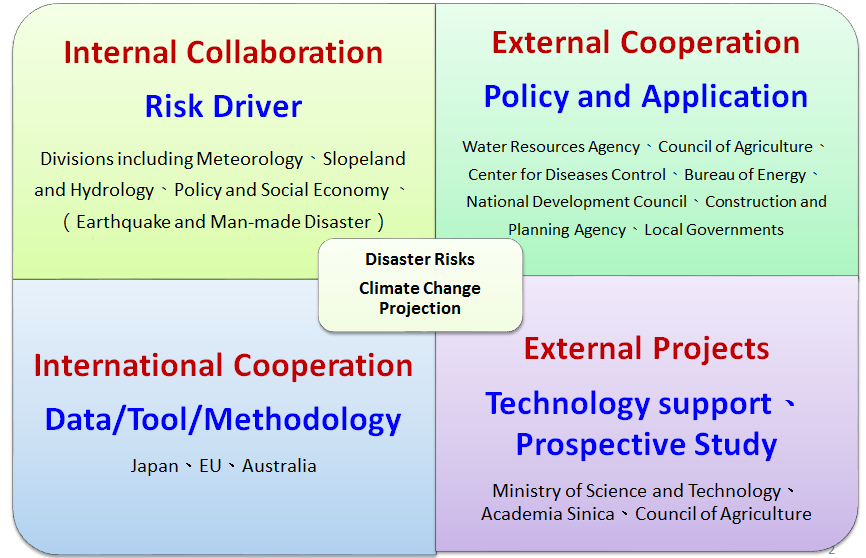The Assessment and Adaptation Strategies for Extreme Climate-related Disaster Risks
Project Purpose
According to NCDR’s researches, the frequencies of extreme rainfalls and typhoons since 2000 have exceeded the occurrence frequency between 1970 and 1999. Extreme rainfalls and typhoons cause severe casualties and economic losses. Typhoon Morakot (the worst typhoon ever recorded in Taiwan) produced extreme rainfall and caused severe damage to Taiwan. Therefore, NCDR has actively developed researches on climate-change impacts to clarify climate-change disaster impacts on Taiwan and provide a reference for the government in formulating climate-change adaptation policies. Sub-projects of this program on disaster reduction are focused on disaster-risk analysis, assessment and management techniques. The sub-projects are conducted to develop disaster-prevention and response strategies for climate, environmental, and socio-economic changes. Assessment reports will be presented on the potential effects of future climate, environmental, and socio-economic changes to provide a reference for the government in enacting long-term disaster-prevention and climate-change adaptation policies.
The project involves the use of climate change-projection data (obtained from the Taiwan Climate Change Projection and Information Platform (TCCIP) funded by the National Science and Technology Council and implemented by the NCDR and related units) to develop critical techniques and integration tools, assess extreme climate-induced disaster risks, and improve adaptation-capability and adaptation-assessment methods. This project is also in collaboration with the adaptation plan for the disaster dimension of the Adaptation Strategy to Climate Change in Taiwan that was proposed by the National Development Council to evaluate disaster-management policies and provide suggestions for reducing climate-change disaster risks.
Collaboration with Other Units
| Unit Name | Work Description |
|---|---|
| National Science and Technology Council: | NCDR works with various research units to implement Taiwan Climate Change Projection and Information Platform (TCCIP) to produce climate change projection data. This project uses these climate projection data for assessing disaster risks. |
| National Development Council: | This project is designed to support the disaster prevention and adaptation research of National Climate Change Adaptation Policy Framework (led by National Science and Technology Council, assisted by NCDR). The project integrates, adjusts and advices the adaptation policies. |
| Water Resources Agency: | NCDR supports technical exchange and cooperation with WRA under water resource adaptation project. |
| Council of Agriculture: | NCDR supports the project ”Agriculture Disaster Risk Indicators Identification and Impact Assessment under Extreme Climate”. |

Figure 1 (From upper- left to lower-left (clockwise)): Relations with other divisions in NCDR, other government agencies and other countries.
Primary Tasks
- Disaster Loss Assessment in river basins under climate change
- Climate risk maps using climate projection data
- Climate change adaptation tools and policy implementation
- Drought and Water Resources Assessment and Integrated Application
- Cooperation on climate related scientific research projects with Ministry of Agriculture, Water Resources Agency and Academia Sinica
Key Achievements
Major Accomplishments
- Conducted Climate risk maps in county scale using climate change projection data
- Published Climate Change in Taiwan: Scientific Report 2011, 2016 version will be available for public soon
- Published Climate Change Disaster Risk Assessment Report
- Implemented action plan for disaster prevention sector under “ National Climate Change Adaptation Policy Framework” with National Development Council
- Translated and published Intergovernmental Panel on Climate Change (IPCC) special report “Managing the Risks of Extreme Events and Disasters to Advance Climate Change Adaptation (SREX)”
Other Accomplishments
- Developed river basin disaster impact and loss assessment tool (pilot project)
- Established drought monitoring and early warning platform with short term seasonal discharge projection
- Production of dynamical downscaled extreme weather events data
- Developed and applied Psuedo Global Warming(PGW) simulation technology on extreme typhoon under climate change
- Developed adaptation policy assessment tool
- Established Taiwan Climate Change Projection and Information Platform [TCCIP] new website and provided climate data service
